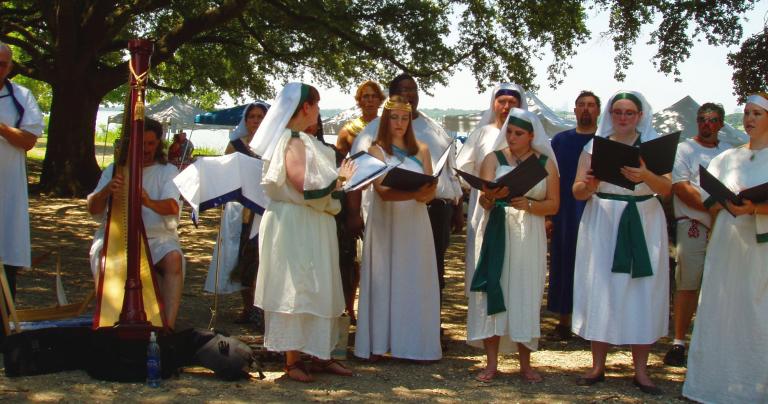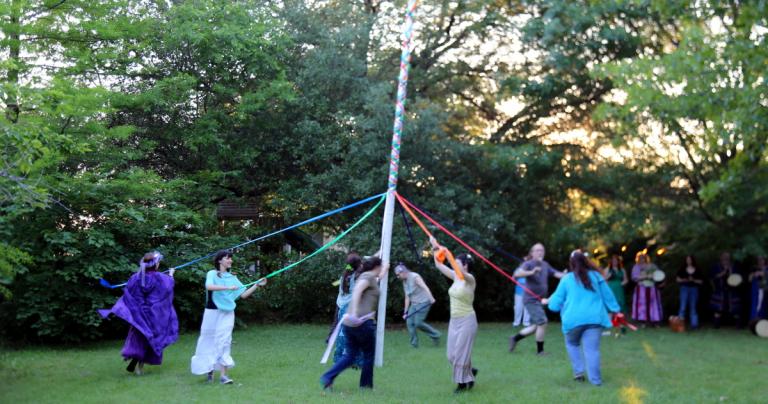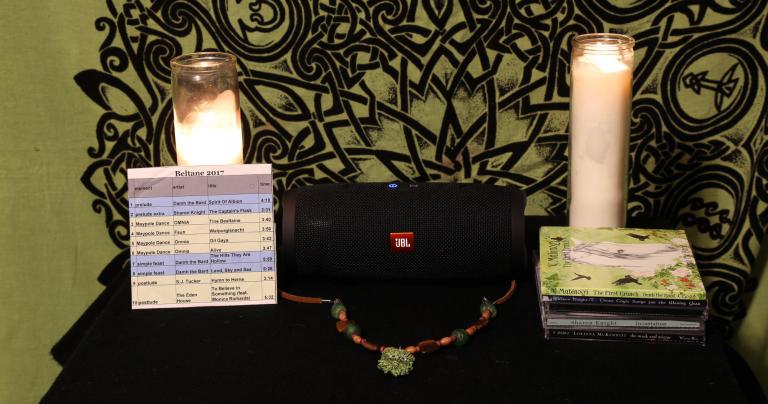Every now and then the topic of recorded music in rituals comes up. Can you use it? Should you use it? How can you use it well? And what kind of music works best?
As with most other questions about what to do or not do in Pagan rituals, the only universal answer is “it depends.” There are some traditions that don’t use music, or that only use songs and chants that all the participants can sing. Others don’t want any technology in a ritual.
There is nothing like live music in a ritual. I’ve been in a OBOD ritual where Damh the Bard played and sang during the Feast. I was in a ritual in White Rock Lake Park in Dallas where 15 members of Vocal Magic were accompanied by two harpists in an ancient Egyptian hymn. I’ve been part of ADF rituals where a near-professional bard led the people in liturgical singing and then provided background music during the sharing of the Waters of Life.

But sometimes you don’t have a guitarist or a harpist in your group. Or you need the volume of a choir but you’ve only got two good singers. Or you really want to use a piece of recorded music to set up or enhance something in your ritual.
I’ve been using recorded music in rituals for years. Here’s what I’ve learned.
Music in public rituals
Let’s start with what I don’t like – I don’t like recorded music for devotion or energy raising. If you’re singing praises to the Deity of the Occasion or if you’re trying to power your group working, even mediocre live singing or chanting is better than recorded music, because it’s participative. It’s the same reason Christian churches with large well-rehearsed choirs or professional worship bands still include congregational hymns in their services. Teach the song or chant before the ritual, if necessary give people handouts with words, and arrange for one or two good singers to set the pace. Then feel the power grow.
But there are other places where recorded music works very well.
Dances. This is the obvious one. If you want people dancing you need music. Doing a Maypole dance? Play Omnia’s “Tine Bealtaine” or Faun’s “Walpurgisnacht.” Lots of Pagan music works for spiral dances. Music for dances is the one place where recorded music usually works better than live music.
Preludes and interludes. Need to get people to stop the pre-ritual socializing and get focused on what’s coming? Play some music. Need a break in between long-but-necessary invocations and the main working? Play some music. I tend to use music for preludes and poetry for interludes (because poetry is usually shorter), but recorded music can make an excellent “palate cleanser.”
Background music for movements. If there are places in the ritual where there are movements but no one is speaking, background music is very helpful. Want people to get up and make a commitment of some sort? Play aggressive music. Want them to make a contemplative offering? Play something soft. Stick to instrumental music here, or music in a non-English (non-local) language – you want people to feel the music, not sing along in their heads.
Simple Feast. If you’ve got more than about a dozen people in your circle, it’s going to take a minute or five to get the cakes and ale (or whatever you use) passed around. And the longer it’s quiet, the greater the chance that people will start talking to each other, and that’s likely to break the mood of the ritual. Play music instead.
Music in private rituals
Private rituals tend to be smaller, less scripted, and more focused on the work at hand. The need for interludes or for music during the Simple Feast is much less. But because the participants usually know each other well, getting people to not just stop their conversations but to forget them can be much harder.
I really like recorded music for preludes before private rituals. Not only will it act to focus the participants on ritual the that’s about to begin, the right song will help set the tone you want to set.
Music in solitary rituals
Solitary rituals tend to be even simpler than private rituals. Unless you’re singing a hymn to a deity, you rarely need any music in a solitary ritual.
But just because you’re the only one doing the ritual doesn’t mean you’re the only one in the house. Maybe your spouse has the TV on, or you’re in the back yard and your neighbors are having a party, or there’s noise coming from nearby streets or highways. In those cases recorded music makes for great background music – something to drown out all the external distractions. I prefer classical music for this – as with the music for movements the lack of words keeps the music from becoming a distraction itself.
I used to play mystical-sounding music when I read Tarot, to get me in the proper frame of mind. I rarely need that anymore, but it was very helpful when I was starting out.
Technical considerations
As with everything else in a ritual, if you’re going to do it then do it well.
If you’re playing music for yourself or for a few people, you may be able to get away with playing it on your phone, particularly if everyone already knows the songs you’re using. For a living room sized ritual, a portable CD player or inexpensive bluetooth speaker will do well.
For larger gatherings, you’re going to need better (i.e. – more expensive) equipment. And for outdoor use, you need something with plenty of volume. If you’re a group that does this often, invest in a quality system.
For the Morrigan devotional ritual at this year’s Mystic South, I used a JBL Charge 3 bluetooth speaker and ran it from my phone. We had about 60 people in a hotel conference room – it was great. For big outdoor rituals I used to use my vintage 1988 rack system, until I blew out the speakers. Not sure what I’ll do next time.
Whatever you use, make sure you test it before the ritual. Nothing like thinking everything’s under control only to find at the last minute that your phone won’t pair with the speaker, or your iPhone lightning connector won’t connect to the amp’s 3.5mm jack, or the CD you burned on your computer won’t play on your friend’s player.
Practice playing the music the same way you practice everything else in a ritual. Know your cues – I call them out in the ritual script. Just knowing when to start the song is one thing. Make sure you also know when to end it, and if you need to let it play all the way through or if you should shut it off when the associated ritual action is finished. And if you do shut it off before the song is over, don’t just hit “stop” – fade it out.
Legal considerations
Recorded music is by definition copyrighted. However, US copyright law specifically exempts music used in live religious services (other countries may have different laws). You can play or sing any song you like from any source and be perfectly legal.
But this exemption only applies to live worship services. It doesn’t apply to concerts and dramatic performances. And it doesn’t apply to recordings and broadcasts. If you record your ritual and put it on YouTube, you’ll need permission for all the songs you use. See this article from LegalZoom for more details.
What music to use?
It’s a special and holy thing to play or sing ancient music in a modern Pagan ritual. But it’s also good to use contemporary Pagan music, or any other music that fits the mood you’re trying to set.
Last year I wrote My Top 10 Pagan Albums of All Time. I used 11 years of ritual playlists to help me figure out the list – and I ended up with 16 albums, not 10. These would be my suggestions for what to use.
You are, of course, free to use what seems best to you. My only warning would be to never force a song into a ritual. Just because it’s really good and you really like it doesn’t mean it fits in a ritual.
There’s something magical about a choir singing a sacred song with power and skill. There’s something special about guitars or harps or drums playing in a ritual. There’s something powerful about ritual participants chanting in unison.
But recorded music has a place in Pagan rituals as well. Find the right songs, put them in the right places, and enjoy them.



















